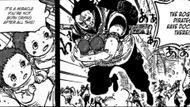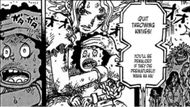One Piece's God Valley incident harbors a chilling possibility. Two crying infants lie abandoned amid the chaos - one destined to become the Red-Haired Emperor who guides heroes, the other fated to evolve into Blackbeard, the nightmare that devours dreams. Young Dragon stands between them, his Marine uniform bloodied, forced to choose which child lives and which dies.
The terrifying truth emerges from recent One Piece manga revelations: Dragon's choice at God Valley didn't just save Shanks - it created Blackbeard's darkness. Had the 17-year-old Marine grabbed Teach instead, Luffy might be learning cruelty from a scarred red-haired monster while seeking inspiration from a gap-toothed dreamer. This singular moment of mercy and abandonment transformed two children into perfect opposites.

The God Valley incident in One Piece revealed that Dragon was the one who saved Shanks but failed to save his twin, Shamrock, as their mother pleaded with him to protect her children. However, recent theories suggest Dragon's choices extended far beyond this single rescue. The young Marine found himself in an ethical dilemma that would define his revolutionary ideals.
Dragon was just 17 years old during the events of God Valley and clearly didn't have any powers at this time. His youth and inexperience made his moral choices even more significant. The speculation proposes that Dragon encountered not just Shanks and Shamrock, but also members of the Davy clan - including a young Marshall D. Teach.
The Trolley Problem Theory

Fan theories suggest Dragon faced what philosophers call the "trolley problem" during the chaos at God Valley. The scenario presents an impossible moral choice: save two babies in his arms or rescue an entire clan facing destruction. This theoretical framework provides a compelling lens through which to examine Dragon's actions during the incident.
The speculation centers on Dragon being forced to choose between immediate rescue and broader salvation. With Shanks and Shamrock already in his care, could he abandon them to save Teach's family? The theory suggests Dragon made the painful decision to prioritize the lives he could definitely save over those he might save.
If this theory holds true, Dragon's decision created a butterfly effect that shaped One Piece's modern era. Shanks, saved by Dragon's intervention, eventually found his way to the Roger Pirates through the treasure chest placement. This rescue led to his mentorship under Roger and eventual rise to become one of the Four Emperors.
Meanwhile, Teach's survival as potentially the lone member of his clan could explain his ruthless nature and deep-seated resentment. The scar Shanks received from Blackbeard serves as physical proof of their connected destinies. The theory suggests this connection runs deeper than a simple pirate rivalry.
Connected Destinies in Volume Covers of One Piece

Supporting evidence for this connection theory comes from One Piece's volume covers. Every cover featuring Marshall D. Teach also includes Shanks, suggesting their fates remain intertwined beyond coincidence. This visual storytelling hints at their shared origin story dating back to the God Valley incident.
The covers serve as subtle foreshadowing for revelations that their rivalry stems from circumstances neither could control. Dragon's choice during God Valley created parallel paths that would eventually converge in Luffy's journey, with one saved child becoming his inspiration and the other becoming his ultimate challenge.
If this speculation proves accurate, it fundamentally changes how fans view the relationships between major One Piece characters. Dragon's role evolves from Luffy's absent father to the architect of his son's greatest friendship and rivalry. The God Valley incident becomes the hidden origin of both Shanks' mentorship and Blackbeard's antagonism.
The theory also raises questions about whether Dragon harbors guilt over his choices. Does he watch Blackbeard's rise with regret, knowing he might have prevented it? This internal conflict could drive future character development as the revolutionary leader confronts the consequences of his youthful decisions.
